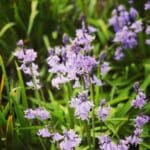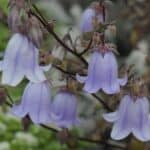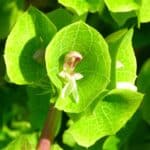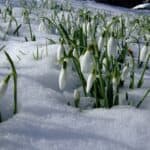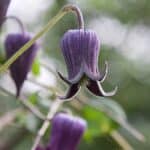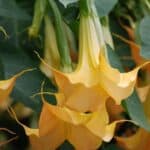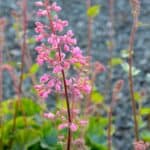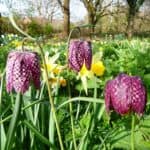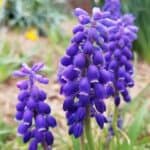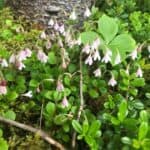Bell-shaped flowers, originally brought from Europe as ornamental plants, are now used by gardeners to revamp their boring gardens.
Many bell shaped flowers are annuals, biennials, or even perennials, and you can grow them in lower USDA zones.
Stick to the article and choose the best ones for your garden from this list.
Table of Contents Show
15+ Bell-Shaped Flowers For Home Gardens
Flowers that look like bells range in different heights, which makes them ideal for gardens, hanging baskets, and pots.
Moreover, the shades of flowers that look like bells range from orange, red, yellow, white, purple, blue, and pink.
Bell shaped flowers serve aesthetic significance and are crucial for drawing garden pollinators like bees, butterflies, and hummingbirds into your garden.
So, let’s go through a list of beautiful flowers that look like bells for your year-round blooming garden.
1. Bluebells (Hyacinthoides species)
Bluebells indicate the arrival of spring. But, to see these flowers bloom in early spring, you must plant them during the fall.
Additionally, they resemble other blue bell flowers, but their stems adorn beautiful linear, alternate green leaves.
They can bloom vigorously if planted under the full sun but can tolerate partial shade and a little frost within zones 4-10.
However, be careful not to overwater them.
2. Bellflowers (Campanula species)
Bellflowers have cup-shaped, tubular blooms that dangle down from the flowering stem of the plant.
Further, their leaves are spatula-shaped, equally decorative with dented, serrated, or entire margins, and leathery.
Most species of Bellflowers are zone 4-10 perennials and grow in wide climatic zones.
Some alpine varieties are only 2 inches tall, making them excellent as garden blankets.
Other Campanula plants can grow up to 2 meters in height, but their growth also depends on how much care they get.
3. Foxgloves (Digitalis purpurea)
Usually, most Foxglove varieties bear trumpet-shaped pink flowers, while others have funnel-shaped ones.
With broad, soft, bluntly toothed edges, and spear-shaped leaves, they complement perfectly with colorful blooms of the plant.
Some varieties can reach 1-2 meters tall. They grow and flower abundantly within the USDA zones 3-8.
Foxgloves can self-seed, and it’s okay to deadhead them if you don’t want any more plants growing in your garden.
4. Bells of Ireland (Moluccella laevis)
Bells of Ireland are also popularly known as ‘shell flowers,’ which people especially grow for their strange green blooms.
These green and white bell-shaped flowers bloom on long stems attached to a 3-4 feet tall plant.
Since shell flowers are self-seed, they will return yearly if you let them remain in your garden.
Moreover, they are ideal for USDA zones as low as 2. This makes them frost tolerant and a summer bloomer in these zones.
Iris people use Bells of Ireland as a gift for a graduation, a new job and good luck.
5. Lily of the Valley (Convallaria majalis)
Lily of the Valley is a fast-growing perennial herb that resides in the cool areas of the northern hemisphere.
Flowers are sweet and perfect for inviting bees into your garden all year round, but they are poisonous.
Because of this crouching habit and frost tolerance, it’s excellent for ground cover within zones 3-9.
Green, smooth, and spatulate leaves arise from the center of the clusters present below the flowering stalk.
6. Snowdrops (Galanthus species)
Snowdrops are tough, frost-tolerant herbaceous plants whose flowers indicate the first sign of spring when they bloom.
Each Snowdrop plant bears 2-3 strappy leaves arising from the base of the plant.
They are zone 3-8 perennials that are hardy and require less care in winter.
There are around 20 species of Snowdrops, and some feature flowers with a yellow or green tinge.
7. Bluebills (Clematis pitcheri)
Unlike other herbaceous plants, Bluebills are unique as it is a vining plant.
Bluebill’s leaves are compound, consisting of 2-8 ovate or lanceolate leaflets, making them adorable for any garden.
One of the features of Bluebills is their long flowering season from late spring to summer and fall from zones 5-9.
Moreover, people often employ the vining habit of the plant (10-13 feet) to decorate garden walls and rock gardens.
8. Angel’s Trumpet (Burgmansia species)
This plant begets trumpet-shaped purple, white, light orange, yellow, or orange bell-shaped tubular.
It can reach a staggering 9-10 feet tall with equally large bell-shaped flowers drooping from a long stem.
Despite its rarity, it is a perennial plant that can always return yearly if you can get your hands on just one plant.
As a tropical plant, it thrives well in zones 8-10 and has a long blooming season from spring until fall.
This plant comprises only 7 species and is sadly extinct in the wild.
9. Coral Bells (Heuchera species)
Coral Bells receive their name due to white to pinkish-red bell-shaped flowers on tall flowering stems rising from the ground from late spring to early summer.
Additionally, the leaves of Coral Bells feature various colors and are palmately lobed.
The plants are shade-loving perennials that flourish within zones 4-9.
Besides, Coral Bell’s vibrant yellow, purple, pink, and green flowers can attract pollinators to your gardens.
10. Fuchsia
Although perennial, Fuchsia can also behave as an annual in colder areas with long winters.
The plant bears opposite leaves set out in whorls, lens-shaped, and sometimes brace serration along the margins.
They bloom from summer until fall in zones 6-7, but you can extend this by regularly fertilizing the plants.
Native Americans used Fuchsia roots to dye wool, while The Maori took the Fuchsia pollen for makeup.
11. Snakeshead Fritillary (Fritillaria meleagris)
Unlike any other bell-shaped flowers, Snakeshead Fritillary has unique checkered blooms, so sometimes, it is also called the “chess flower.”
These flowers resemble the leaves of lily plants having narrow edges, grass-like and green, and arranged in wide spacing in the stem.
Likewise, Snakeshead flowers in spring from zones 3-8. They become 6-12 inches tall with blooms atop thin stems.
Chess flowers can be flawless border plants and elevate the aesthetic décor of your garden.
12. Grape Hyacinths (Muscari species)
Muscari is a mid-spring blooming plant with clustered grape-like purple flowers on the top of the stem.
Each inflorescence consists of 40 individual flowers. These flowers can also appear in white, pink, or greenish-blue colors.
They are well-adapted in USDA zones 3-9, so you can consider them frost-hardy species.
They are popular flowering plants as they re-emerge in mid-fall after they die in summer.
13. Mountain Laurel (Kalmia latifolia)
Also known commonly as Calico Bush, Mountain Laurels produce beautiful hexagonal bell-shaped flowers having a towering height of 1.5-9 feet.
They can bloom better in full sun but are also shade tolerant, but for consistent blooming, set them under partial shade.
Laurels are ideal for USDA zones 4-9, flowering in late spring until summer in these areas.
Additionally, the leaves have an alternate arrangement. Each leaf is elliptical, with an entire margin, waxy-green shine, and pointed tips.
14. Twin Flowers (Linnaea borealis)
Twin Flowers get their name from 2 pink bell-shaped flowers that grow in pairs and droop down from the tip of the Y-shaped stem.
The flowers are also equally fragrant, complementing its looks, and can invite pollinators into your garden or patios.
Additionally, this frost-tolerant herbaceous perennial is hardy to zones 3-8.
Besides, the plant leaves nearly attain a circular shape with notched tips. In some varieties, leaves arise in pairs, oppositely arranged in the stem.
15. Daffodils (Narcissus species)
Gardeners plant Daffodils via bulbs in the fall, and they bloom in next late winter or early spring.
Daffodils have many strap-shaped, ligulate, and narrow basal leaves surrounding the flowering stalks.
You can grow Daffodils as frost-tolerant border plants in zones 3-8.
There are 25 different species of Daffodil, along with 13,000 hybrids, which bloom for up to 50 years.
16. White Mountain Heather (Cassiope species)
White Mountain Heather, or Western Moss Heather, is a perennial sub-shrub with white bell-shaped flowers.
But avid gardeners appreciate Heathers for flowers and their scaly leaves covering the entire stem.
Normally, they attain a small size of 0.5-1 foot tall and grow in dense groups.
Due to their growing habit, Heathers are small woody plants, growing as perennials from zones 6-7.
7 Additional Bell Shaped Flowers
The following list hosts the rest of the bell-shaped flowers that people adore.
| Flowers | Growth Requirements | Trait & Use |
|---|---|---|
| Penstemon (Perennials) | Sunlight: Full Sun to Partial Shade Soil & pH: Well-draining moist soil with 5-8 pH Hardiness Zone: 4-9 | Flower Color: Blue, Purple, Pink, or Red Use: Great for attracting pollinators Flowering Season: Spring to Summer |
| Canterbury Bell Flower (Biennials or Perennials) | Sunlight: Partial Shade Soil & pH: Well-draining moist soil with 6-8 pH Hardiness Zone: 4-10 | Flower Color: Violet-blue Use: Border plants Flowering Season: Late Spring or Early Summer |
| Swamp Doghobble (Annuals or Perennials) | Sunlight: Full Sun Soil & pH: Moist, cool soil with 5-6 pH Hardiness Zone: 5-9 | Flower Color: White Use: Slope planting, Near ponds or Woodland gardens Flowering Season: Spring to Early Fall |
| Tulips (Perennials) | Sunlight: Full Sun to Partial Shade Soil & pH: Well-draining with 6-6.5 pH Hardiness Zone: 3-8 | Flower Color: Pink, Red, Yellow, White, or Orange Use: Ornamental garden plant Flowering Season: Spring |
| Snowdrop Tree (Perennials) | Sunlight: Full to Partial Shade Soil & pH: Well-draining moist soil with 5-6 pH Hardiness Zone: 6-9 | Flower Color: White Use: Lawn planting, Privacy plant or Woodland gardens Flowering Season: Spring |
| Persian Lilies (Perennials) | Sunlight: Full Sun Soil & pH: Well-draining moist soil with <6 pH (acidic) Hardiness Zone: 4-8 | Flower Color: Green, Ivory, Deep Red, or Deep Purple Use: Deer and Rabbit resistant Flowering Season: Spring |
| Korean Bell Flowers (Perennials) | Sunlight: Full Sun to Partial Shade Soil & pH: Moist well-draining soil with 6.5-7 pH Hardiness Zone: 4-8 | Flower Color: Shades of White and Pink Use: Speedy growing ornamental garden plant Flowering Season: Mid to Late Summer |
Bell Shaped Flowers That Attract Hummingbirds
While choosing flowers for your garden next time, be generous to all the microfauna visiting there, either for permanent settlement or to come by periodically.
However, Hummingbirds only dwell in distinct flowers. Their feeding habit allows them to use their siphon-like beaks to reach the nectar present in the flower.
Hence, bell-shaped, aromatic, and nectar-producing flowers are what hummingbirds love.

If you want to start a garden and don’t want them to feel left out, try planting these bell-shaped flowers that attract hummingbirds.
| Flowers | USDA Zones |
|---|---|
| Cardinal Flowers | 2-9 |
| Bee Balms | 4-9 |
| Hosta | 3-9 |
| Catmint | 3-9 |
| Agastache | 4-9 |
| Eastern Red Columbine | 3-8 |
| Trumpet Honeysuckle | 4-10 |
| Salvia | 3-10 |
| Lupine | 4-8 |
| Petunia | 10-11 |
| Delphinium | 3-9 |
| Trumpet Creeper | 4-10 |
From Editorial Team
By considering all their requirements, you can encourage the plants to set vivid and colorful flowers that look like bells.
However, pick the suitable plant to grow depending on your living zone.

